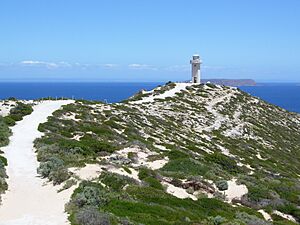Protected areas of South Australia facts for kids

Protected areas of South Australia are special places in South Australia and its nearby ocean waters. These areas are looked after by the South Australian Government. They are set aside to protect nature, wildlife, and important historical sites.
As of 2018, South Australia had 359 different protected areas. These areas cover a huge amount of land, about 211,387 square kilometers. That's like 21.5% of the whole state!
Contents
Who Looks After Protected Areas?
The government of South Australia is mainly in charge of creating and managing protected areas within the state and its coastal waters. They use laws like the National Parks and Wildlife Act 1972 to do this. This act helps create most of South Australia's contribution to Australia's National Reserve System.
Other laws also help protect different types of areas. These include acts for forests, wilderness, historic shipwrecks, the River Murray, dolphin sanctuaries, marine parks, and native plants.
The main Australian Government doesn't usually make laws for protected areas inside South Australia. However, they can work with the state government on bigger projects. For example, they might agree to protect wetlands that are important worldwide, or create special areas managed by Indigenous communities.
The National Parks and Wildlife Act 1972
This act is the most important law for protected areas in South Australia. It helps set up and manage different types of reserves. It also helps protect native plants and animals, controls hunting, and looks after wildlife.
The Department for Environment and Water (DEW) is the government group that manages this act.
By 2021, there were 359 parks and reserves under this act. They cover a huge area, about 19.6% of South Australia.
The act lists different kinds of protected areas:
- National parks
- Conservation parks
- Game reserves
- Recreation parks
- Regional reserves
What are National Parks?
National parks are very important areas. They are special because of their wildlife, amazing natural features, or important Aboriginal and European history.
Here are some of South Australia's national parks:
- Adelaide International Bird Sanctuary—Winaityinaityi Pangkara
- Belair
- Coorong
- Flinders Chase
- Ikara-Flinders Ranges
- Dhilba Guuranda-Innes
- Kati Thanda-Lake Eyre
- Lincoln
- Naracoorte Caves
- Nullarbor
What are Conservation Parks?
Conservation parks are areas protected to save wildlife or important natural and historical features.
Some examples of conservation parks include:
What are Game Reserves?
Game reserves are special areas set aside to protect wildlife. They also allow for hunting during certain seasons, but this is carefully managed.
Here are some game reserves:
- Bool Lagoon
- Bucks Lake
- Chowilla
- Lake Robe
What are Recreation Parks?
Recreation parks are areas managed for people to enjoy nature and have fun. You can often go for walks, picnics, or other outdoor activities here.
Some recreation parks are:
- Anstey Hill
- Blackwood Forest
- Granite Island
- O'Halloran Hill
- Sturt Gorge
What are Regional Reserves?
Regional reserves are areas protected for their wildlife or natural features. They also allow for some responsible use of natural resources.
Examples include:
- Chowilla
- Innamincka
- Nullarbor
- Yellabinna
Other Ways South Australia Protects Areas
Conservation Reserves
These are pieces of land set aside to protect natural and cultural features. They are managed under the Crown Land Management Act 2009.
Examples include:
Native Forest Reserves
The Forestry Act 1950 allows for areas of native forest to be protected. These reserves help conserve native plants and animals. They are managed by ForestrySA.
These reserves are found in places like the Flinders Ranges, Mount Lofty Ranges, and the Limestone Coast.
Wilderness Protection Areas
The Wilderness Protection Act 1992 was created to protect wild, untouched areas. It also helps restore land to how it was before European settlement. The DEW manages these areas.
Some wilderness protection areas are:
- Billiatt
- Danggali
- Memory Cove
- Nullarbor
Protected Zones for Historic Shipwreck Sites
The Historic Shipwrecks Act 1981 protects areas around old shipwrecks. This helps preserve these important historical sites underwater.
Examples include:
- HMAS Hobart Shipwreck Reserve
- Zanoni Shipwreck Reserve
River Murray Protection Area
The River Murray Act 2003 aims to protect and improve the Murray River and its surrounding areas and ecosystems.
This includes the floodplain of the River Murray in South Australia, as well as Lake Alexandrina, Lake Albert, and the Coorong.
Aquatic Reserves
Aquatic reserves are special areas in the ocean and estuaries (where rivers meet the sea). They are set up to protect the amazing variety of underwater plants and animals.
Some aquatic reserves are:
Adelaide Dolphin Sanctuary
The Adelaide Dolphin Sanctuary is a special area created to protect the Indo-Pacific bottlenose dolphins that live in the Port Adelaide River estuary and Barker Inlet. It also helps protect and improve these water areas. The DEW manages this sanctuary.
Marine Parks
Marine parks are protected areas in the ocean waters near South Australia. They are set up to protect the wide range of sea life and environments, while still allowing for careful, sustainable use of natural resources.
South Australia has many marine parks, including:
- Far West Coast Marine Park
- Nuyts Archipelago Marine Park
- Investigator Marine Park
- Neptune Islands Group (Ron and Valerie Taylor) Marine Park
- Franklin Harbor Marine Park
- Encounter Marine Park
Arkaroola Protection Area
The Arkaroola Protection Act 2012 created the Arkaroola Protection Area. This area is about 600 kilometers north of Adelaide. It's managed to protect its unique environment and stop mining activities. This area is like a National Park because of its high level of protection.
Native Vegetation Heritage Agreements
A heritage agreement is a special, legally binding promise between a landowner and the government. The landowner agrees to protect native plants on their land forever. In return, they might get help with things like fencing or expert advice to protect the area. These agreements help protect important natural areas across South Australia.

